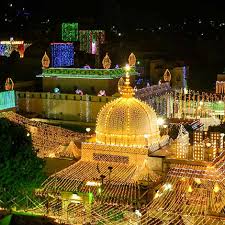Portion of building on Ajmer Dargah premises collapses, Centre blamed for ‘neglect’

On July 2, 2025, a part of the Ajmer Sharif Dargah complex collapsed around 2 PM. The affected structure was an old hut near the Shah Jani Masjid, close to the Chhabili Gate. Heavy monsoon rains weakened the building. Luckily, the area had been cordoned off due to the rains, preventing injuries or fatalities.
Millions visit this shrine yearly to pay respects to Sufi saint Khwaja Moinuddin Chishti. The collapse raised fresh concerns about the condition of the complex and the safety of its visitors.
Religious Leaders Accuse the Central Government
Leaders of the hereditary caretakers, called Khadims, quickly blamed the Union Ministry of Minority Affairs. They said the government-appointed Dargah Committee neglected maintenance duties. Syed Sarwar Chishti, a spokesperson for the Khadims, said the committee left the key position of Nazim vacant for over three years. He also pointed out that nine other committee seats remain unfilled.
Chishti stated, “Repeated requests to repair the deteriorating structures were ignored.” He called the situation “institutional apathy” and “neglect by the Centre.” The Khadims claim that warnings about structural risks were ignored despite heavy rainfall each year.
Structural Neglect: An Ongoing Problem
Experts say the Ajmer Dargah has suffered from years of inadequate upkeep. The 800-year-old complex needs constant inspection and repairs to keep it safe. A local architect who has worked on heritage projects commented, “We wait for damage before we act. The Dargah’s heritage and public safety both suffer because of bureaucratic delays.”
The Dargah falls under the Dargah Khwaja Saheb Act of 1955, which gives the government-appointed committee control over administration and repairs. Critics say political disinterest and insufficient funds have crippled the committee’s ability to maintain the site.
Government Assurances and Repair Plans
Nazim Mohammad Bilal Khan, a retired BSF DIG recently appointed to the post, acknowledged the collapse was due to heavy rain worsening weak structures. He assured the public that the committee had already begun repair work and planned further strengthening.
“We are conducting a full structural audit and addressing the weak sections,” Khan said. He also mentioned that contractors had been appointed before the collapse to improve the infrastructure. However, some community members remain skeptical about the speed and transparency of these efforts.
Heritage and Faith at Risk
The Ajmer Dargah is more than a religious shrine. It stands as a symbol of India’s cultural diversity. Pilgrims of all faiths visit the site, which hosts many national and international dignitaries. The collapse raises questions about how India protects such living heritage.
Dr. Nida Ahmad, a historian, said, “Heritage sites cannot survive on paper committees alone. Delay in action threatens both the structures and the traditions they represent.” She called for better cooperation among religious leaders, conservation experts, civil society, and the government.
Public Demand for Accountability
Following the collapse, social media buzzed with criticism. Many activists highlighted government spending on large projects while neglecting sacred heritage sites. Online petitions demand an independent audit of all structures in the Dargah complex.
These petitions call for a transparent management system that includes input from religious caretakers and conservation specialists. Public pressure now mounts for swift and effective reforms.
Conclusion: A Call to Protect India’s Heritage
Although no one was hurt, the Ajmer Dargah collapse exposed long-term neglect. It serves as a warning to the government and society. Protecting such sites requires urgency and commitment.
As the monsoon season continues, authorities must act quickly to prevent future accidents. The safety of millions of pilgrims and the preservation of India’s cultural heritage depend on it.






